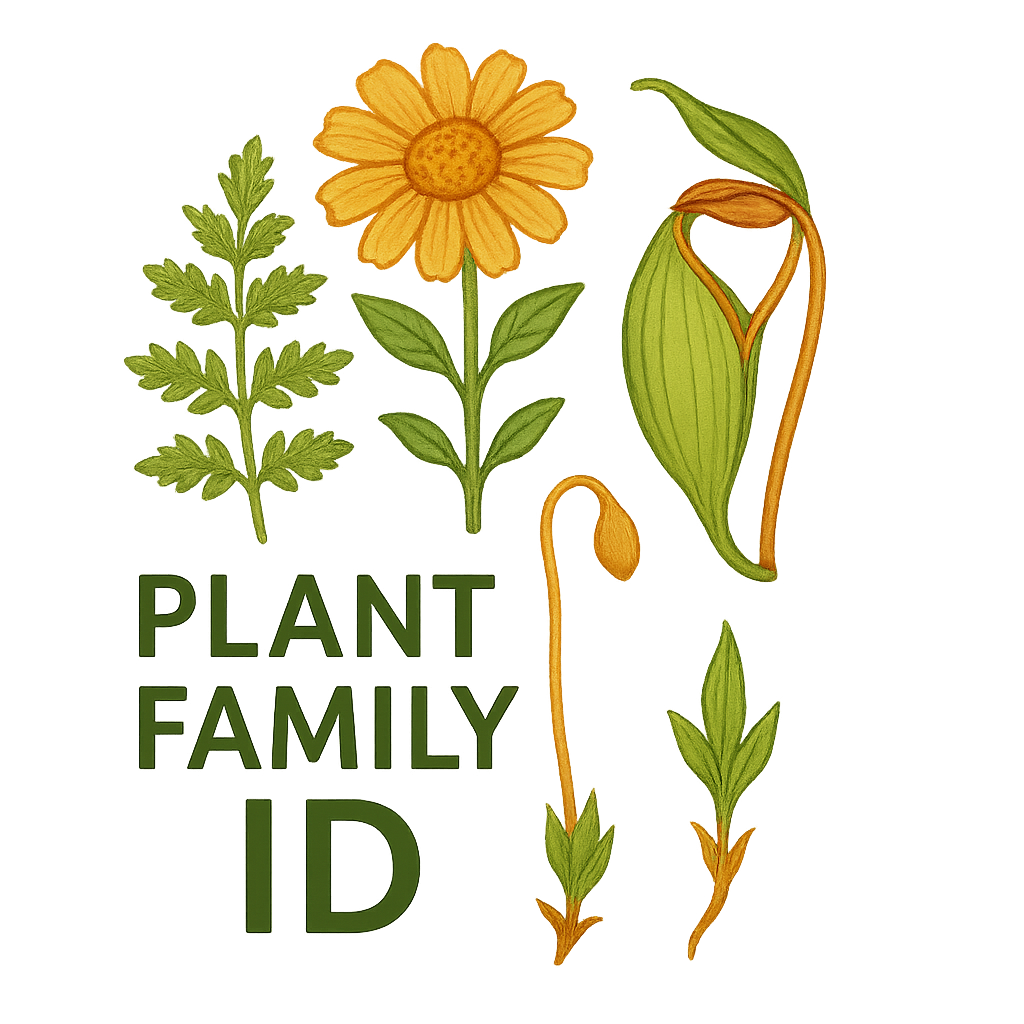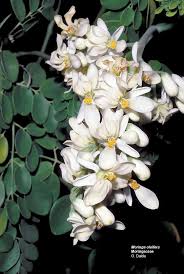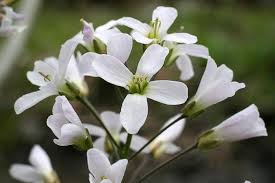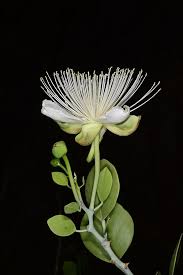Caricaceae
Papaya Family
The Caricaceae, or Papaya family, is a small but economically significant family belonging to the order Brassicales. It consists of short-lived perennial trees and shrubs characterized by their typically soft, thick, often unbranched stems (pachycaul habit), large, palmately lobed or compound leaves clustered at the stem apex, and the presence of milky latex. Found primarily in the Neotropics (with one genus in Africa), the family is famed for Carica papaya, the source of the papaya fruit, and contains proteolytic enzymes like papain. Flowers are usually unisexual, and the fruit is a large, fleshy berry.
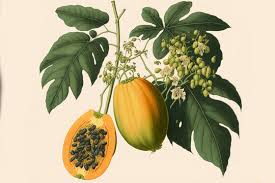
Overview
Caricaceae is a member of the order Brassicales, within the Rosid clade (specifically Malvids), linking it chemically to families like Brassicaceae (mustards) through the shared production of glucosinolates (mustard oil glycosides). Despite its small size (around 6 genera and 35 species), the family holds major economic importance due to Carica papaya, cultivated throughout the tropics for its edible fruit and the enzyme papain.
The family exhibits a distinctive growth form: most species are pachycaul, meaning they have disproportionately thick trunks or stems for their height, often with soft wood and little branching. Large, palmately divided leaves are clustered near the apex, giving them a palm-like appearance. Milky latex is present throughout the plants. Most species are dioecious (separate male and female plants), contributing to variability in fruit production. The fruit is consistently a large, multi-seeded berry.
The family's natural distribution is centered in tropical Central and South America, with a notable disjunction represented by the genus Cylicomorpha in tropical Africa. They typically inhabit tropical forests and disturbed areas.
Quick Facts
- Scientific Name: Caricaceae Dumort.
- Common Name: Papaya family
- Number of Genera: Approximately 6
- Number of Species: Approximately 35
- Distribution: Primarily Neotropics (Tropical C. & S. America), one genus (Cylicomorpha) in Africa.
- Evolutionary Group: Eudicots - Rosids (Malvids) - Order Brassicales
Key Characteristics
Growth Form and Habit
Plants are typically short-lived perennial shrubs or small trees (up to 10-15m, but often smaller). They exhibit a characteristic pachycaul growth form with thick, succulent, often unbranched or sparsely branched stems containing soft wood and prominent leaf scars. All parts contain articulated laticifers producing milky latex.
Leaves
Leaves are arranged alternately but are typically crowded into a dense spiral cluster at the apex of the stem or branches. They are large, often deeply palmately lobed or palmately compound, borne on long, hollow petioles. Stipules are absent (exstipulate).
Inflorescence
Inflorescences are typically axillary, taking the form of cymose clusters or panicles. Male inflorescences are often long-peduncled and much-branched. Female inflorescences are usually much simpler, with fewer flowers, sometimes reduced to a single flower.
Flowers
Flowers are typically unisexual (plants usually dioecious, sometimes monoecious or polygamous, especially in cultivated papaya), actinomorphic (radially symmetrical), and 5-merous. There are distinct differences between male and female flowers:
- Male Flowers (Staminate): Possess a calyx of 5 small sepals. The corolla is sympetalous (fused petals), forming a slender tube with 5 lobes (tubular or funnel-shaped). There are typically 10 stamens in two whorls (5 outer, 5 inner), inserted on the corolla tube (epipetalous). A rudimentary pistil (pistillode) is usually present.
- Female Flowers (Pistillate): Also have 5 small sepals. The 5 petals are much larger than in male flowers and are nearly free or only fused shortly at the base, often fleshy. Staminodes (sterile stamens) may be present. The ovary is superior, large, composed of typically 5 fused carpels. It is usually 1-locular with numerous ovules on 5 intrusive parietal placentas, or sometimes incompletely 5-locular at the base. Styles are 5, short, each bearing a fan-shaped or branched stigma.
Fruits and Seeds
The fruit is a large, fleshy berry, variable in size and shape (e.g., globose, pyriform, melon-like in papaya). The flesh develops from the ovary wall. It contains numerous seeds attached to the parietal placentas lining the central cavity. Seeds are typically ovoid, with a rough testa (seed coat), and often surrounded by a gelatinous or fleshy outer layer (sarcotesta). Endosperm is present and oily.
Chemical Characteristics
As members of Brassicales, Caricaceae produce glucosinolates (mustard oil glycosides). They are also characterized by the presence of milky latex containing proteolytic enzymes, most notably papain and chymopapain in Carica papaya, which have various industrial applications (e.g., meat tenderizer, digestive aids).
Field Identification
Caricaceae are relatively easy to identify due to their distinctive growth habit and leaf morphology, especially when combined with their tropical distribution and the presence of latex.
Primary Identification Features
- Pachycaul Habit: Thick, soft, often unbranched trunk/stem is highly characteristic.
- Apical Cluster of Large Palmate Leaves: Large, palmately lobed or compound leaves crowded at the stem apex.
- Milky Latex: Presence of white latex when any part of the plant is cut or broken.
- Large Berry Fruit: If present, the large, fleshy berry (like a papaya) is diagnostic.
- Unisexual Flowers: Common condition (dioecious or monoecious), with distinct male and female flower structures.
- Superior Ovary: Easily observed in female flowers.
Secondary Identification Features
- Alternate Leaf Arrangement: Though clustered, the underlying arrangement is alternate/spiral.
- Soft Wood: Stems are not densely woody.
- Tropical Distribution: Primarily found in the tropical Americas (plus one African genus).
- Brassicales Chemistry: Although not testable in the field, the underlying presence of glucosinolates confirms its order.
Seasonal Identification Tips
- Year-Round: The pachycaul habit, leaf shape and arrangement, and latex are identifiable throughout the year. Prominent leaf scars on the trunk are often visible.
- Flowering/Fruiting Season: Flowers (often borne directly on trunk or older stems in some species - cauliflory) and the distinctive large berries appear during warmer/wetter growing seasons. Sex of the plant can be determined when flowers are present.
Common Confusion Points
- Other Pachycaul Plants: Some Euphorbiaceae (e.g., Jatropha) or Apocynaceae (e.g., Plumeria) can have thickened stems and latex, but differ significantly in leaf shape (often simple in Plumeria), flower structure (often bisexual, different ovary position/structure), and fruit type (capsules, follicles).
- Plants with Large Palmate Leaves: Some Araliaceae (e.g., Schefflera) have large palmate leaves clustered apically but lack latex and have very different flowers (small, often in umbels, inferior ovary) and fruits (drupes or berries, usually small). True palms (Arecaceae) have a very different stem structure (no secondary growth) and distinct flower/fruit types.
- Related Brassicales: Moringaceae (Moringa oleifera) has pinnately compound leaves and long, capsular fruits. Other Brassicales are mostly herbaceous or have different habits.
Field Guide Quick Reference
Look For:
- Pachycaul stem (thick, soft)
- Large, palmate leaves at apex
- Milky latex
- Large berry fruit
- Unisexual flowers (common)
- Superior ovary (female fl.)
Key Variations:
- Leaves: Lobed vs. Compound
- Sexuality: Dioecious vs. Monoecious
- Branching: Unbranched vs. Sparsely branched
- Fruit size and shape
Notable Examples
While a small family, Caricaceae contains the globally important papaya and several related species cultivated or used locally.

Carica papaya
Papaya
The most famous species, widely cultivated in tropical and subtropical regions worldwide. A fast-growing, typically unbranched pachycaul tree reaching 5-10m. Valued for its large, sweet, melon-like berry fruit. The latex is the source of the enzyme papain. Cultivated varieties exhibit diverse fruit shapes, sizes, colors, and sexual systems.

Vasconcellea species
Mountain Papayas (e.g., Babaco)
A genus closely related to Carica, native to the Andes of South America. Includes species like V. cundinamarcensis (Mountain Papaya) and the hybrid cultivated fruit V. × heilbornii (Babaco). They are generally more tolerant of cooler conditions than Carica papaya. Fruits vary but are often more acidic or used for cooking/preserves; Babaco fruit is seedless and parthenocarpic.

Jacaratia species (e.g., J. spinosa)
Jacaratia
A Neotropical genus of trees that can grow larger and more branched than papaya, sometimes reaching 20-30m. Trunks may be smooth or bear conical spines (especially when young). Leaves are palmately compound. Fruits are edible, berry-like, similar to papaya but often smaller or different shapes.

Cylicomorpha species (e.g., C. parviflora)
African Papaya relative
The only genus of Caricaceae native to Africa (found in tropical forests). Consists of pachycaul trees sharing the family characteristics: latex, palmately lobed leaves clustered apically, unisexual flowers (dioecious), and large berry fruits. Represents an interesting biogeographic link to the Neotropical members.
Phylogeny and Classification
Caricaceae is a member of the large and diverse order Brassicales, located within the Malvid clade of Rosids. Molecular studies confirm its placement in this order, consistent with the shared production of glucosinolates (mustard oil compounds).
Within Brassicales, Caricaceae is believed to be closely related to Moringaceae (containing Moringa oleifera, the horseradish tree). These two families, along with others like Setchellanthaceae, Limnanthaceae, and Tropaeolaceae, form part of the complex branching pattern within the order, distinct from the core Brassicaceae group. The distinct morphology of Caricaceae (pachycaul habit, large berries) represents a unique evolutionary trajectory within the Brassicales.
Position in Plant Phylogeny
- Kingdom: Plantae
- Clade: Angiosperms (Flowering plants)
- Clade: Eudicots
- Clade: Rosids (Malvids / Eurosids II)
- Order: Brassicales
- Family: Caricaceae
Evolutionary Significance
Caricaceae provides insights into several aspects of plant evolution:
- Morphological Specialization within Brassicales: Represents a unique development of the pachycaul tree/shrub habit within an order dominated by herbs or more conventionally woody plants.
- Evolution of Sexual Systems: The prevalence of dioecy (separate sexes) in wild populations, contrasted with the varied systems in cultivated papaya, offers a model for studying the evolution of plant reproductive strategies.
- Domestication and Economic Botany: Carica papaya is a prime example of a tropical fruit crop domesticated from wild ancestors, showcasing selection for fruit size, sweetness, and horticultural traits.
- Biogeography: The presence of Cylicomorpha in Africa, while the rest of the family is Neotropical, points to ancient dispersal events or vicariance shaping the distribution of the Brassicales order.
